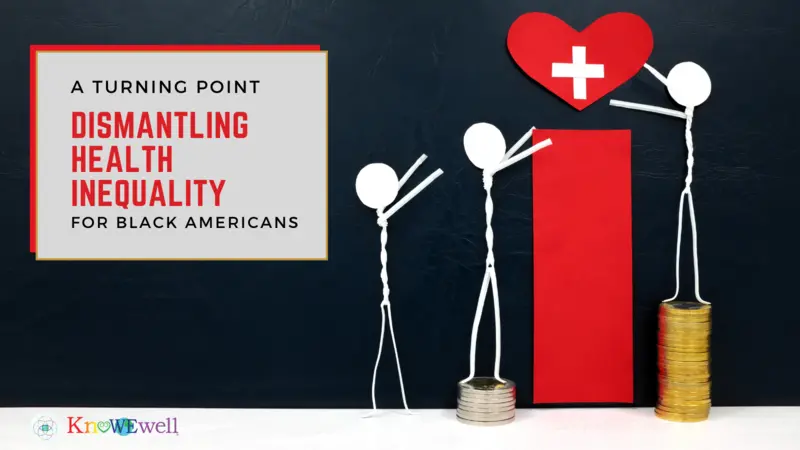

Community

Community
Dismantling Health Inequality
Could this be a turning point for healthcare for Black Americans?
Minority groups have been hit hardest by the COVID-19 pandemic, exposing the inequalities that have been a stark reality in America since the founding of the nation. Black Americans face disproportionate numbers of COVID-19 cases, hospitalizations, and as of March 2021, had nearly two times the death rate of white Americans from the virus, according to the Centers for Disease Control and Prevention (CDC). Minority groups are more likely to be “essential” workers with minimal or no paid sick days, are more likely to rely on public transportation, and are more likely to live in crowded housing situations—with all these realities contributing to a much higher exposure to infection from the virus.
Black Americans are more likely to have underlying chronic health conditions, less likely to have health insurance, and have lower life expectancy than white Americans. This group has higher death rates than whites from heart disease, stroke, cancer, asthma, influenza, and diabetes, among others. New statistics released by the federal government show life expectancy for the Black population declined by 2.7 years in the first six months of 2020, widening the life expectancy gap between Black and white Americans to six years, the largest it has been in more than two decades.
The crisis of these racial health disparities, compounded by the pandemic and fueled by the anger unleashed last summer following George Floyd's death, have given rise to a new urgency for action to address health inequality in the country.
The economic costs of health disparities are enormous, responsible for an estimated annual loss of $42 billion in lowered productivity and $93 billion in additional medical costs, according to a 2018 study by the W. K. Kellogg Foundation and Altarum.
While some view health outcomes as the result of individual choices, Dr. Lisa Cooper, a health disparities researcher at the Johns Hopkins Bloomberg School of Public Health, told National Public Radio that health is also the result of a lack of choices, noting there is a large body of research linking residential segregation to the negative health effects that come from living in areas with fewer options for education, healthy foods, and green spaces. The health disparities seen today are the result of decades of systemic inequities, not only in healthcare, but across a spectrum of economic, housing, and social systems.
Life expectancy for Black Americans declined by 2.7 years in the first six months of 2020.
Policies enacted generations ago have had long-term effects on the health of the Black population in America today. In 2020 researchers from the National Community Reinvestment Coalition, the University of Richmond, and the University of Wisconsin-Milwaukee compared “redlining maps” of the 1930s with current economic status and health outcomes in the same neighborhoods today. Redlining maps, created by the federal Home Owners’ Loan Corporation to evaluate the riskiness of mortgage lending, rated Black and immigrant neighborhoods as high risk, discouraging investment. This and other discriminatory housing policies resulted in decaying neighborhoods that attracted dirty industries and few retailers, leaving residents with pollution, fewer schools, less green space, and poor access to healthy food.
Helen Meier, an epidemiologist and coauthor of the study, told NPR that redlining has shaped neighborhoods in ways that impact health: “Where we live impacts our exposure to health-promoting resources and opportunities.” Neighborhoods that were redlined in the 1930s, researchers found, have higher rates of chronic diseases such as asthma, hypertension, obesity, and diabetes. Other research has shown that racial health disparities are reduced in more racially integrated communities.
Not only have racist policies worsened health outcomes for Black Americans, but discrimination itself has direct health consequences. A majority of Black Americans report racial discrimination as a chronic stressor, the cumulative burden of which is linked to a variety of conditions, such as increased inflammation, higher infant death rates, greater risk of cancer, depression, and substance abuse.
The American Academy of Pediatrics, in 2019, identified racism as having a profound impact on the health of children, adolescents, young adults, and their families. The Family and Community Health Study (FCHS), a National Institutes of Health-funded study that followed 800 Black American families over 25 years, found that participants who reported high levels of discrimination when they were young teenagers had significantly higher levels of depression in early adulthood. Disrupted cortisol levels, elevated blood pressure, and higher body mass index are all linked to childhood discrimination.
A majority of Black Americans report racial discrimination as a chronic stressor.
A 2014 study published in the American Journal of Preventive Medicine found that Black Americans had a faster rate of telomere shortening—the wearing down of the ends of chromosomes associated with cellular aging—compared to whites. The study concluded that racial discrimination, along with the internalization of racial bias, “has pernicious effects on biological aging, and that this is one pathway through which social inequities generate greater disease vulnerability in this population.”
The Black population has a long history of distrust of the healthcare system, a reality that is playing itself out in the COVID-19 vaccination program. A report released in November 2020 by the National Association for the Advancement of Colored People found that only 14% of Black respondents said they trust the safety of the COVID-19 vaccine. This compares to 58% of the overall US population, according to another November poll, released by Gallup.
The seeds of this distrust were planted with abuses like the infamous Tuskegee study in which syphilis treatment was deliberately withheld from Black patients. Experts say the subtle assaults of present-day racism in healthcare perpetuate these attitudes. In an article published in the New England Journal of Medicine, Simar Singh Bajaj of Harvard College and Fatima Cody Stanford, MD, MPH, MPA, of Harvard Medical School wrote that every day in America, “Black Americans have their pain denied, their conditions misdiagnosed, and necessary treatment withheld by physicians.”
If there is a silver lining to the tragic racial health consequences and social injustices of the past year, it may be that they have served as a wake-up call across many institutions to begin the work of fixing the unequal healthcare system.
At the forefront of the initiative is the Othering and Belonging Institute at UC Berkeley, a hub of scholars, researchers, communicators, policymakers, and community partners working since 2012 to advance belonging for all members of society. The organization’s Diversity and Health Disparities Cluster directly addresses ethnic and racial health inequities through research, teaching, and policy activity on the deeply rooted social inequalities that result in disproportionate rates of illness and death in marginalized groups.
Othering and Belonging Institute founder and director john powell, JD, an internationally recognized expert in civil rights, civil liberties, structural racism, housing, poverty, and democracy, and coauthor, Eloy Toppin, Jr, MPP, recently published an article in the American Medical Association’s Journal of Ethics in which they propose a “targeted universalism” strategy for addressing health disparities. “In regard to health care, this means that treatments, outcomes, and strategies for providing access will differ across population groups if the universal goal is a certain level of desirable healthiness for all groups measured by frequency of contact with the health care system, life expectancy, or a number of other indicators.” Such a targeted strategy recognizes that not all groups have the same starting point, so one-size-fits-all policies and approaches proposed by lawmakers and others will not achieve their desired outcome.
“Black Americans have their pain denied, their conditions misdiagnosed, and necessary treatment withheld.”
A localized approach advocated by the World Health Organization is the interprofessional collaboration approach. This model, based on the philosophy that no healthcare profession can tackle the pervasive national crisis of racial health disparities on its own, provides patients with a comprehensive team of experts across multiple disciplines in order to treat the whole patient. Research has shown an interprofessional approach to healthcare can reduce medical errors and hospital readmissions, decrease mortality rates, and improve health outcomes for those with chronic conditions. Other research has shown that when institutions have more diverse boards that better represent the populations, they serve they make better decisions and drive better outcomes.
The Academy of Integrative Health and Medicine (AIHM), founded in 1978, and led by Mimi Guarneri, MD, FACC, ABOIM, is the leading professional organization for holistic and integrative health and medicine. It is at the vanguard and ideally poised to advance this approach as interprofessional collaboration and education is its hallmark. Further, this past year, the AIHM initiated monthly webinars devoted to fighting racism, created a BIPOC Task Force, and committed to a more representative board of directors. AIHM refocused its 2020 annual conference as a call to action for healthcare providers around the globe to explore structural racism within integrative and traditional healthcare.
In recent months, organizations from multiple disciplines have committed to increasing diversity in leadership and expanding diversity training. Integrative Medicine for the Underserved (IM4US), founded in 2009 to bring affordable, accessible integrative healthcare to all, with a focus on underserved populations, has more than a decade of experience bridging the healthcare gap through outreach, education, research, and advocacy. In 2020, IM4US re-formed its board of directors so that half now come from Black, Indigenous and People of Color (BIPOC) communities. IM4US implemented implicit bias training for its staff and focused its annual conference on structural racism and integrative health equity.
The Institute for Functional Medicine (IFM), founded by Dr. Jeffrey Bland and his wife, Susan Bland, in 1991, has in recent months diversified its board and staff and has made a commitment to changing coursework and materials to include a focus on diversity, equity, and inclusion. The IFM has made addressing affordability and accessibility of functional medicine a priority. Some of the other organizations that have made commitments and strides toward diversity, equity, and inclusion include the Integrative Health Policy Consortium, the National Acupuncture Detoxification Association, Society for Integrative Oncology, the Maryland University of Integrative Health, and the American Chiropractic Association.
In June 2020, the American Medical Association (AMA) Board of Trustees denounced racism and identified it as an urgent threat to public health and pledged action to confront and combat systemic racism. The new policy adopted by the AMA, representing physicians and medical students from every state and medical specialty, pledges to identify a set of best practices to mitigate the effects of racism, expand research funding into the epidemiology of risks and damages related to racism, and protect against the influences of racism and bias in innovative health technologies.
If there is a silver lining to the tragic racial health consequences of the past year, it may be that they have served as a wake-up call to begin the work of fixing the unequal healthcare system.
Michellene Davis, executive vice president and chief corporate affairs officer at RWJBarnabas Health, in New Jersey, told US News that leadership inclusion and diversity are only the beginning: “You must ask: How does this policy, this protocol, this new procedure affect and impact and enhance structural racism?” For example, she says, a 15-minute window for appointments could have health repercussions for a person who struggles to find childcare, relies on public transportation, arrives after the 15-minute window, and is turned away.
A new paper published in Nature proposes one way that innovative technology could help reverse healthcare inequality. The authors looked at the Kellgren-Lawrence grade (KLG), a methodology in which a radiologist reviews a knee x-ray and scores a patient’s pain that is standard practice for clinical evaluation of knee pain associated with knee osteoarthritis. Data collected by the National Institutes of Health found that doctors using KLG systematically score a Black patient’s pain as far less severe than the patient reported experiencing, a finding that led researchers to hypothesize that the methodology itself is biased.
Using an artificial intelligence (AI) model to predict patients’ self-reported pain, researchers found that the AI model was much more accurate than KLG at predicting self-reported pain levels for both white and especially for Black patients, reducing the racial disparity by nearly half. The study revealed that the standard method for evaluating pain is flawed, at a greater cost to Black people, leading researchers to suggest these types of algorithms may be used to improve diagnostic tools to remove bias and generate new knowledge.
Efforts to correct systemic inequities have been initiated by some hospitals and health systems through innovative programs that position hospitals as “not just a provider of clinical services, but really as a part of the fabric of the community,” Dr. Bruce Siegel, president and CEO of America’s Essential Hospitals, told US News. This “anchor system” of healthcare takes a localized approach dedicated to the health and well-being of those that are most vulnerable within their communities and begins with hiring and investing locally. When healthcare organizations intentionally agree and share the anchor mission with other local institutions such as schools, faith-based centers, government agencies, and others, success follows, say experts.
Research has shown that bringing healthcare services to the communities where people live can improve outcomes. A 2018 study showed that 64% of Black men brought their blood pressure levels to normal after a monitoring site was set up in a barbershop—a trusted fixture in the Black community—compared with only 12% of the control group.
Efforts to correct systemic inequities have been initiated by some hospitals and healthcare systems.
Creating a physician workforce that is more representative of the country can improve racial health disparities. Black Americans make up 13% of the US population, yet they currently account for only 5% of physicians. Research has shown Black patients prefer to be treated by a Black physician and will go out of their way to do so. When Black newborns are cared for by a Black doctor, infant mortality is reduced by 50%.
Some medical schools, such as the historically black college Morehouse School of Medicine, have put less emphasis on MCAT scores for medical school admission. Research has shown that although underrepresented groups have lower mean MCAT scores, these differences are not due to differences in aptitude but to differences in opportunities because of structural racism. Studies have shown that the MCAT is not a significant predictor of success in medical school.
The Andrew Weil Center for Integrative Medicine at the University of Arizona recently announced targeted scholarships for students from marginalized communities and committed to expanding diversity content in the university’s College of Medicine curriculum.
“We will never achieve a truly universal healthcare system … without confronting the public health impacts of structural racism.”
Clyde Yancy, MD, Vice Dean for Diversity and Inclusion at Northwestern’s Feinberg School of Medicine suggested in an interview with JAMA Network that medical schools could open up a steady flow of new Black physicians by simply increasing class sizes by just one to two minority students.
The federal government is poised to take action on healthcare inequality. On his first day in office, President Biden signed an executive order on racial equity to “pursue a comprehensive approach to advancing equity for all, including people of color and others who have been historically underserved, marginalized, and adversely affected by persistent poverty and inequality.” In addition, the Anti-Racism in Public Health Act was reintroduced to Congress on February 2 to help educate the public and expand research and investment into the public health impacts of systemic racism through the creation of a National Center for Anti-Racism at the CDC. The legislation will also require the federal government to begin actively developing anti-racist policy.
While much work remains to be done to rectify decades of health inequality, awareness and commitment are growing within the healthcare industry. Jamila Taylor, senior fellow at The Century Foundation, says, “We will never achieve a truly universal healthcare system that works for everyone without confronting the public health impacts of structural racism.”
REFERENCES
Allen, A. (2015, January 27). “I can't breathe”: Racial injustice, segregation, and health disparities. Othering & Belonging Institute. https://belonging.berkeley.edu/i-cant-breathe-racial-injustice-segregation-and-health-disparities
American Medical Association. (2020, November 16). New AMA policy recognizes racism as a public health threat. https://www.ama-assn.org/press-center/press-releases/new-ama-policy-recognizes-racism-public-health…?
Bajaj, S. S., & Stanford, F. C. (2021, February 4). Beyond Tuskegee: Vaccine distrust and everyday racism. New England Journal of Medicine. https://www.nejm.org/doi/full/10.1056/NEJMpv2035827?
Brenner, G.H. (2020, December 11). Education may protect black women from racism-related aging. Psychology Today. https://www.psychologytoday.com/us/blog/experimentations/202012/education-may-protect-black-women-r…
Butler, S. M. (2020, December 8). Four COVID-19 lessons for achieving health equity. JAMA, 324(22), 2245–2246. https://doi.org/10.1001/jama.2020.23553
Carter, S. (2020, November 17). Racial discrimination ages Black Americans faster, according to a 25-year-long study of families. The Conversation. https://theconversation.com/racial-discrimination-ages-black-americans-faster-according-to-a-25-yea…
Center for American Progress. (2020, May 7). Health disparities by race and ethnicity. https://www.americanprogress.org/issues/race/reports/2020/05/07/484742/health-disparities-race-ethn…
Chae, D. H., Nuru-Jeter, A. M., Adler, N. E., Brody, G. H., Lin, J., Blackburn, E. H., & Epel, E. S. (2014). Discrimination, racial bias, and telomere length in African-American men. American Journal of Preventive Medicine, 46(2), 103–111. DOI: 10.1016/j.amepre.2013.10.020
Congresswoman Barbara Lee. (2021, February 1). Lee, Pressley, Warren reintroduce bold legislation to confront structural racism as a public health crisis. https://lee.house.gov/news/press-releases/lee-pressley-warren-reintroduce-bold-legislation-to-confr…
Godoy, M. (2020, November 19). In U.S. cities, the health effects of past housing discrimination are plain to see. National Public Radio. https://www.npr.org/sections/health-shots/2020/11/19/911909187/in-u-s-cities-the-health-effects-of-…?
Hao, K. (2021, January 22). AI could make health care fairer—by helping us believe what patients say. MIT Technology Review. https://www.technologyreview.com/2021/01/22/1016577/ai-fairer-healthcare-patient-outcomes/?
Weeks, J. (2020, December 12). In the time of George Floyd’s murder: Update on actions from 18 integrative health organizations and institutions. The Integrator Blog. http://www.johnweeks-integrator.com/uncategorized/in-the-time-or-george-floyds-murder-update-on-act…
Khullar, D. (2017, June 8). How prejudice can harm your health. The New York Times. https://www.nytimes.com/2017/06/08/upshot/how-prejudice-can-harm-your-health.html
Levine, D. (2020, November 20). Health care providers tackle racism and disparities in care. U.S. News & World Report. https://www.usnews.com/news/health-news/articles/2020-11-20/health-care-providers-tackle-racism-and…
Lucey, C. R. & Saguil, A. (2020, March). The consequences of structural racism on MCAT scores and medical school admissions: The past is prologue. Academic Medicine, 95(3), 344-350. https://journals.lww.com/academicmedicine/Fulltext/2020/03000/The_Consequences_of_Structural_Racism…
Murphy, B. (2021, January 29). How to get up to 3,000 more Black people in physician pipeline. American Medical Association. https://www.ama-assn.org/education/medical-school-diversity/how-get-3000-more-black-people-physicia…
National Conference of State Legislatures. (2020, November 16). Health disparities overview. https://www.ncsl.org/research/health/health-disparities-overview.aspx
Opam, K. (2020, November 17). Americans are more willing to take a coronavirus vaccine, poll suggests. The New York Times. https://www.nytimes.com/2020/11/17/health/gallup-poll-coronavirus-vaccine.html
Othering & Belonging Institute. https://belonging.berkeley.edu/
powell, j.a. & Toppin, E. (2021, February). Health equity and the circle of human concern. AMA Journal of Ethics. 2021;23(2):E166-174. doi: 10.1001/amajethics.2021.166.
Tavernise, S., & Goodnough, A. (2021, February 18). A grim measure of Covid’s toll: Life expectancy drops sharply in US. The New York Times. https://www.nytimes.com/2021/02/18/us/covid-life-expectancy.html
The White House. (2021, January 20). Executive order on advancing racial equity and support for underserved communities through the federal government. https://www.whitehouse.gov/briefing-room/presidential-actions/2021/01/20/executive-order-advancing-…
Vanderbilt, A. A., Dail, M. D., & Jaberi, P. (2015). Reducing health disparities in underserved communities via interprofessional collaboration across health care professions. Journal of Multidisciplinary Healthcare, 8, 205–208. https://doi.org/10.2147/JMDH.S74129
US Department of Health & Human Services Office of Minority Health. (n.d.) Profile: Black/African Americans. https://minorityhealth.hhs.gov/omh/browse.aspx?lvl=3&lvlid=61


 By
By
 Reviewed by
Reviewed by







